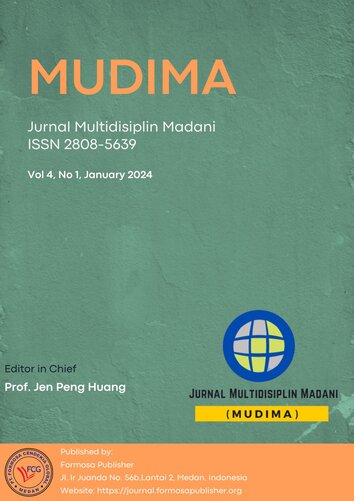Evolution of Cybercrime Law in Legal Development in the Digital World
DOI:
https://doi.org/10.55927/mudima.v4i1.7962Keywords:
Cybercrime Law, Information and Communication Technology, Cross-Border Cooperation, Data Protection, Law Enforcement, Cybercrime ThreatsAbstract
This research explores the evolution of cybercrime law in the face of developments in information and communication technology (ICT) over the last few decades. The development of digital technology has provided countless benefits but has also given rise to increasingly complex threats in the form of cyber attacks and cybercrime. This research aims to investigate how cybercrime law has evolved in response to changes in ICT and how these developments have influenced the effectiveness of cybercrime law enforcement. This research also analyzes the role of cross-border cooperation in cybercrime law enforcement and how developments in international law have influenced countries' ability to deal with global cybercrime threats. The research results show that the evolution of cybercrime law includes the establishment of more specific cybercrime laws and stronger protection of personal data. Cross-border cooperation plays an important role in cybercrime law enforcement, including information exchange, joint prosecution, asset freezing, and extradition. Developments in international law, such as the Budapest Convention and the General Data Protection Regulation (GDPR), have provided the legal basis necessary for more effective cross-border cooperation. However, challenges remain, including legal and jurisdictional differences between countries that often hamper law enforcement efforts. Therefore, increasing international cooperation and efforts to overcome these obstacles is critical in maintaining security and privacy in the ever-evolving digital era
References
Alexandrou, A. (2021). Cybercrime and information technology: The computer network infrastructure and computer security, cybersecurity laws, Internet of Things (IoT), and mobile devices. CRC Press.
Alghamdi, M. I. (2020). A descriptive study on the impact of cybercrime and possible measures to curtail its spread worldwide. International Journal of Engineering Research and Technology, 9, 731-5.
Almazkyzy, K., & Esteusizov, Y. N. (2018). The essence and content of cybercrime in modern times. Journal of Advanced Research in Law and Economics, 9(3 (33)), 834-841.
Babanina, V., Tkachenko, I., Matiushenko, O., & Krutevych, M. (2021). Cybercrime: History of formation, current state and ways of counteraction. Amazonia Investiga, 10(38), 113-122.
Belch, G. E., & Belch, M. A. (2018). Advertising and promotion: An integrated marketing communications perspective. mcgraw-hill.
Bunga, D. (2019). Legal response to cybercrime in global and national dimensions. PADJADJARAN Jurnal Ilmu Hukum (Journal of Law), 6(1), 69-89.
Chandler, D., & Fuchs, C. (2019). Digital objects, digital subjects: Interdisciplinary perspectives on capitalism, labour and politics in the age of big data. University of Westminster Press.
Choi, K. S., Lee, C. S., & Louderback, E. R. (2020). Historical evolutions of cybercrime: From computer crime to cybercrime. The Palgrave handbook of international cybercrime and cyberdeviance, 27-43.
Holt, T. J., Bossler, A. M., & Seigfried-Spellar, K. C. (2022). Cybercrime and digital forensics: An introduction. Routledge.
Jayasekara, S. D., & Abeysekara, I. (2019). Digital forensics and evolving cyber law: case of BIMSTEC countries. Journal of Money Laundering Control, 22(4), 744-752.
Khan, S., Saleh, T., Dorasamy, M., Khan, N., Tan Swee Leng, O., & Gale Vergara, R. (2022). A systematic literature review on cybercrime legislation. F1000Research, 11, 971.
Kovacs, A. M. (2022). Here there be Dragons: Evolution, Potentials and Mitigation Opportunities of Cybercrime in Nigeria: A Review, Analysis, and Evaluation. Journal of Central and Eastern European African Studies, 2(1).
Losavio, M. M., Pastukov, P., Polyakova, S., Zhang, X., Chow, K. P., Koltay, A., ... & Ortiz, M. E. (2019). The juridical spheres for digital forensics and electronic evidence in the insecure electronic world. Wiley Interdisciplinary Reviews: Forensic Science, 1(5), e1337.
Malik, J. K., & Choudhury, S. (2019). A Brief review on Cyber Crime-Growth and Evolution. Pramana Research Journal, 9(3), 242.
Marion, N. E., & Twede, J. (2020). Cybercrime: An encyclopedia of digital crime. Bloomsbury Publishing USA.
Payne, B. K. (2020). Defining cybercrime. The Palgrave handbook of international cybercrime and cyberdeviance, 3-25.
Rakha, N. A. (2023). Cyber Law: Safeguarding Digital Spaces in Uzbekistan. International Journal of Cyber Law, 1(5).
Ruddin, I. (2023). Manfaat Integrated Marketing Communications dan Penerapan Strategi Content Marketing. Media Sains Indonesia.
Ruddin, I., & Jamalullail, J. (2022). The Development of New Media in the Economic Growth of the Indonesian Music Industry. Ilomata International Journal of Management, 3(4), 470-485.
Ruddin, I., Santoso, H., & Indrajit, R. E. (2022). Digitalisasi Musik Industri: Bagaimana Teknologi Informasi Mempengaruhi Industri Musik di Indonesia. Jurnal Pendidikan Sains dan Komputer, 2(01), 124-136.
Ruddin, I., Santoso, H., Indrajit, R. E., & Dazki, E. (2021). Big Entertainment’s Film and Music Creation Design: Platform-Based Business Model Canvas and Enterprise Architecture. Capture: Jurnal Seni Media Rekam, 13(1).
Ruddin, I., Santoso, H., Indrajit, R. E., & Dazki, E. (2021). Contingency Planning in IT Risk Audit on Music Digital Recording Company. Journal of Music Science, Technology, and Industry, 4(2), 191-209.
Ruddin, I. (2023). Memilih Strategi Brand Management Yang Baik. Media Sains Indonesia.
Schjolberg, S. (2020). The History of Cybercrime (Vol. 13). BoD–Books on Demand.
Smith, P. R., & Zook, Z. (2019). Marketing communications: Integrating online and offline, customer engagement and digital technologies. Kogan Page Publishers.
Świątkowska, J. (2020). Tackling cybercrime to unleash developing countries’ digital potential. Pathways for Prosperity Commission Background Paper Series, 33, 2020-01.
Widijowati, D. (2022). Legal Complexity in Dealing with Cyber Crime in Indonesia. Research Horizon, 2(6), 597-606.
Younies, H., & Al-Tawil, T. N. E. (2020). Effect of cybercrime laws on protecting citizens and businesses in the United Arab Emirates (UAE). Journal of Financial Crime, 27(4), 1089-1105.
Downloads
Published
How to Cite
Issue
Section
License
Copyright (c) 2024 Isra Ruddin, Subhan Zein SGN

This work is licensed under a Creative Commons Attribution 4.0 International License.
































